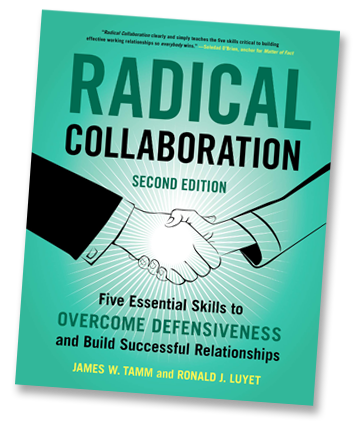For more information about Jim Tamm’s conference/keynote presentations or information about Radical Collaboration training, please contact us through this website.
RADICAL COLLABORATION DAILY PRACTICE™
Online Follow-up program
This online course will help you integrate into your daily life essential skills for building and maintaining strong collaborative relationships and environments. The content is built on and deepens the concepts described in the book "Radical Collaboration" and taught worldwide in the standard 3-day Radical Collaboration workshop. It is a follow-up course only available to individuals who have completed the Radical Collaboration workshop.
The principles are applicable in both work and interpersonal relationships. Applying these principles will dramatically increase engagement, openness, accountability, awareness and conflict resolution skills in all your relationships.

Ron Luyet is co-founder of The Green Zone Culture Group whose consulting practice focuses on building collaborative work environments and he is a Senior Global Consultant with Business Consultants Inc. of Japan. He is also co-creator of the Radical Collaboration partnership building training program offered in countries around the globe.
Read more ...


Celeste is an international consultant and co-founder of The Green Zone Culture Group, a consortium of radically collaborative professionals dedicated to creating superior ways to work together. Her focus is on helping individuals, teams and leaders cultivate the mindset, attitude and skills that are required for building high-trust, collaborative relationships.
Read more ...
Three different ways
The RED ZONE - PINK ZONE - GREEN ZONE concept is a way of describing the culture of an organization. The RED ZONE is a more adversarial, conflicted and hostile environment. The PINK ZONE is a more conflict avoidant, passive aggressive environment. The GREEN ZONE is a more collaborative, supportive environment. We rarely see an organization that is pure RED ZONE, PINK ZONE or GREEN ZONE; most are a unique combination of all three, to varying degrees. However, the chart below gives you a good indication of the difference between an organization that is primarily RED or PINK or primarily GREEN.
Introduction to Red Zone, Pink Zone & Green Zone Attitudes
RED ZONE
- Fear-based
- Defensive
- Combative Tone
- Win for self only
- Defeat others
- Self-interest only
- Feels like warfare
- Rigid/Reactive
- Hostile
- Attacking
- Controlling
PINK ZONE
- Fear-based
- Protective
- Avoidant Tone
- Avoid losing
- Survive others
- Self-interest only
- Feels like guerilla warfare
- Rigid/Reactive
- Passive-aggressive
- Manipulating
- Withholding
GREEN ZONE
- Trust-based
- Collaborative
- Cooperative Tone
- Mutual gain
- Connect with others
- See others as partners
- Feels like problem solving
- Open to influence
- Curious
- Joint effort
- Engaging
CLIMATE SURVEY
and weaknesses of collaborative skills within your organization.
The survey measures five skills found to be essential in building and maintaining collaborative environments and relationships.
The new 2nd edition of Radical Collaboration (HarperCollins, Jan. 2020) first explores the range of attitudes people bring to the task of collaboration and relationship building. A hostile, adversarial Red Zone attitude and a conflict avoidant, passive aggressive Pink Zone attitude is contrasted with a more effective and collaborative Green Zone attitude. Maintaining a Green Zone attitude is the single most important thing readers can do to increase their effectiveness when working to turn conflict into collaboration.
The book offers readers a series of practical tools they can implement immediately to create stronger, more collaborative relationships and organizations. Readers learn to better deal with their own defensiveness and that of others, negotiate their way through the conflict that is inevitable in any long-term relationships, solve problems meeting the interests of all the parties, and build more collaborative environments and relationships.
Relationship Profile
If you have bought the book and want to complete the FIRO Element B Assessment Online, follow this link. You will be asked for some basic demographic information and payment information. Follow the instructions for completing the assessment, and when you’re done your scores will be displayed. You can copy them down or you can print the page. Once you obtain your scores, you can use them to complete the exercises in Chapters 7 and 8.


